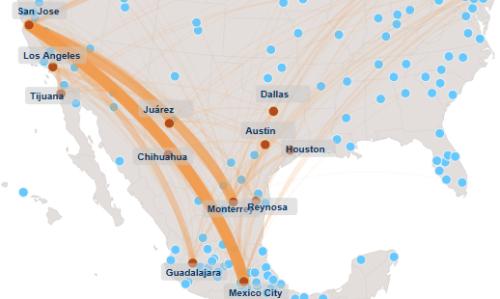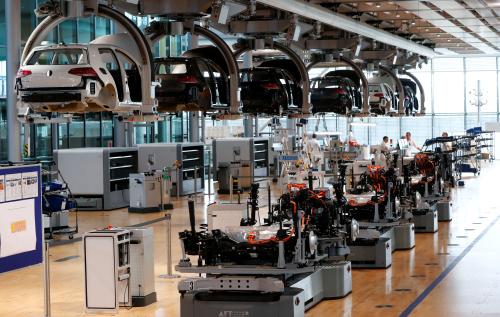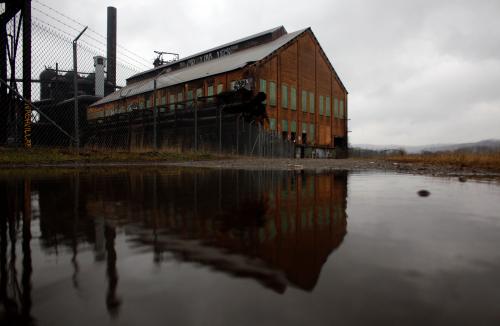Immigration, climate change, and national security loom large in North American relations. But trade is what really defines the U.S. relationship with Canada and Mexico, its first- and third-largest national trading partners, respectively. As our new report Metro North America shows, cities and metropolitan areas drive the North American economy, and trade with one another in the advanced products that power the North American export platform. This week, we are in two Mexican hubs of that metropolitan network, Querétaro and Mexico City, with metro and state leaders from across the continent for our second annual Global Cities Initiative forum, focused on boosting North American competitiveness.
As it turns out, the largest trade flows occur between our largest metro areas, such as New York and Toronto, and Mexico City and Los Angeles, reflecting their significant production and consumption capacities. But there is another set of metro areas that are quintessentially North American in their trade profile, exchanging a large volume of their internationally traded goods with other metro partners across the continent. Most are located well beyond the border, highlighting the nearly three-quarters of trade between our nations that happens outside the border states. Here are the 10 metro areas for which trade with Canada and Mexico accounts for the largest share of total metro goods trade.
1. Bakersfield, CA
Population: 839,631
Total Goods Trade with North America: $2.1 billion
North American Share of Total Trade: 44%
Bakersfield in California’s Central Valley is a major oil refining locale, and as a result trades over $1.1 billion in energy products with Canada and Mexico. It’s also a center of agriculture, an industry that accounts for $375 million in trade between Bakersfield and its continental partners.
2. El Paso, TX
Population: 804,123
Total Goods Trade with North America: $1.7 billion
North American Share of Total Trade: 41%
El Paso sits on the Texas-Mexico border, across the Rio Grande from Ciudad Juarez, Mexico. It is one anchor of a bi-national, regional economy that engages in significant trade and shared production in manufacturing industries such as electronics, machinery, and metals located on both sides of the border.
3. Detroit-Warren-Livonia, MI
Population: 4,296,250
Total Goods Trade with North America: $24.3 billion
North American Share of Total Trade: 39%
Detroit remains the largest hub in the auto industry, perhaps the quintessential North American industry, with significant production occurring in the United States, Canada, and Mexico. Over two-thirds of Detroit’s trade in North America is in motor vehicles and parts, led by the metro’s Big Three auto companies and a dense network of smaller suppliers whose supply chains stretch from Ontario to central Mexico.
4. Jackson, MS
Population: 567,122
Total Goods Trade with North America: $3.3 billion
North American Share of Total Trade: 39%
Jackson ranks among several smaller Southern and Midwestern U.S. metro areas with highly North American-focused trade due to the presence of large auto assembly plants, such as Nissan in nearby Canton, MS. Of the $3.3 billion Jackson traded with North American partners in 2010, $2.2 billion was in motor vehicles and parts.
5. Youngstown-Warren-Boardman, OH-PA
Population: 565,773
Total Goods Trade with North America: $3.1 billion
North American Share of Total Trade: 39%
In addition to its important role in the North American auto industry, Youngstown remains one of the steelmaking capitals of the United States, and as such plays a critical role in supplying steel for advanced industries throughout the continent.
6. Toledo, OH
Population: 610,001
Total Goods Trade with North America: $4.8 billion
North American Share of Total Trade: 37%
Notwithstanding significant manufacturing job losses over the last few decades, Toledo remains a key hub in the auto supply chain, and a critical center of North American trade in that industry. Among the top 10 metro areas, it has the highest per-capita trade volume within North America. Many of its key metro trading partners locate in close-by Ontario.
7. Louisville, KY-IN
Population: 1,235,708
Total Goods Trade with North America: $5.7 billion
North American Share of Total Trade: 36%
Louisville’s North American trading focus also reflects its specialization in auto manufacturing, as the metro is home to a major Ford plant and a strong supplier base. The presence of GE Appliances also accounts for Louisville’s strong electronics trade with supply chain partners in major metros throughout Mexico.
8. Nashville-Davidson–Murfreesboro, TN
Population: 1,670,890
Total Goods Trade with North America: $6.2 billion
North American Share of Total Trade: 35%
In the last two decades, Nashville has emerged as a major auto production center in the South thanks to major General Motors and Nissan plants. $3.1 billion of its North American trade is in motor vehicles and parts, and it links to Mexican production centers such as Puebla and Saltillo as a result.
9. Kansas City, MO-KS
Population: 2,009,342
Total Goods Trade with North America: $9.2 billion
North American Share of Total Trade: 34%
Kansas City is a major hub for North American trade in several ways. Motor vehicle manufacturing accounts for a significant share of its trade flows with Mexico and Canada, as does chemical manufacturing and agriculture, reflecting the metro’s status as one of the premier agribusiness centers on the continent. Kansas City also houses one of the leading rail hubs along the NAFTA corridor.
10. Tulsa, OK
Population: 937,478
Total Goods Trade with North America: $4.7 billion
North American Share of Total Trade: 34%
Just over one-third of Tulsa’s total international trade occurs with Canada and Mexico, overwhelmingly in energy products due to the metro area’s specialization in the oil and gas industry. Tulsa links to the energy capitals of Calgary and Edmonton in Canada, as well as major markets such as Mexico City, Monterrey, and Reynosa in Mexico as a result.
The Brookings Institution is committed to quality, independence, and impact.
We are supported by a diverse array of funders. In line with our values and policies, each Brookings publication represents the sole views of its author(s).











Commentary
The United States’ 10 Most North American Metro Areas
November 12, 2013